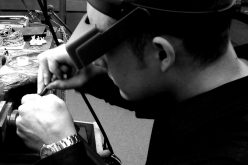Today, websites offer up music on a silver platter of convenience: iTunes and Rhapsody allow consumers to download digital music files, and music streaming sites such as Spotify and Mog allow listeners to access entire albums for free on the date of release.
Despite having cheap and easy access to music, consumers are still paying for tunes.
In its 2011 industry report, the data gathered from Nielsen SoundScan showed digital sales to be up 28 percent from last year. While overall, album and track sales showed very little growth — at barely over 1 percent — vinyl records saw a 36 percent increase in sales over the past year, making vinyl the fastest growing medium in the industry.
As the standard medium, vinyl has long been replaced by a slew of new technology, and had even been dubbed as archaic. Today it is not the most convenient or inexpensive way to listen to music. So, what has spurred this vinyl renaissance in the digital age?
At Sound Warehouse on Block Avenue, vinyl sales are up, and according to manager Mykal White, everyone is buying records — from teenagers to seniors — and they all have their own reasons.
White speculates that many young adults younger than 20 listen to music in a digital format, and that children younger than 10 may have never seen a stand-alone CD player, let alone a record player. For the younger generations, any tangible mediums associated with music have all but disappeared.
White says that for these younger generations, seeing an album paired with a corresponding physical object is a novelty.

Staff Photo by Blair Jackson: Melissa Jones (foreground) and Mikala Parton search through vintage albums at Sound Warehouse in Fayetteville.
“Listening to digital music is like eating fast food or snacks your entire life. For these kids who are listening to vinyl records for the first time, it’s shocking and really satisfying. It feels like you’re biting into a steak when you listen to a record,” says White.
One possible correlation between the digital music age and the vinyl renaissance is in the consumers’ ability to filter through thousands of genres and artists. Having virtually unlimited access to music allows consumers to choose their investments wisely. In this way, the vinyl culture has changed. The new generation of listeners no longer anticipates an album’s release. Often, because of leaks in the entertainment industry, albums are available digitally — albeit illegally — long before the release date.
Vinyl offers an extended experience, and “experience” is what White says people are craving. “You can listen to 50,000 MP3s online, but where’s the experience at?” he asks.
Cheap and easy is no longer the bottom line — at least in the music industry. Though spending more money for a product may seem counterintuitive to trends, it is in fact, simply part of a new trend, says White. “You can buy food from McDonald’s, but people still prefer to go to the farmers’ market. You pay a premium to spend more time and receive better quality.”
Shopping at the farmers market, like shopping at a record store — allows for social interaction and a connection to the community.
Vinyl records are meant to be played out loud, making it ideal for social settings. It can also be an enveloping experience for a single individual. The medium itself requires interaction — taking the record from its case, placing it on the turntable, dropping the needle. And because songs cannot be looped or shuffled, switching songs or albums is another action, another part of the experience. It is a very conscious, deliberate process.
“The experience of listening to music has become a background thing, but music was supposed to be experienced, not just listened to,” says White.
With a new generation of listeners and digital technology at hand, the re-emergence of vinyl has taken on new cultural meaning. In response to the vinyl trend, many new artists are beginning to release LPs with MP3 files included, and when White pulls up his sales for the day, the numbers show that, out of the vinyl record sales, the store has sold 60 percent new releases and 40 percent vintage.
Within the past year, Sound Warehouse has added special ordering to its list of services. The special order book, which used to be only a few pages, is now thick with orders and receipts.
White says the older generations are especially appreciative of this service, as it enables them to effortlessly acquire rare items. Avid collectors also rely on special ordering for new releases of their favorite obscure or independent bands. While most customers call, email or place orders in-person, some of the long-standing Sound Warehouse clients will text the manager to place orders.
One such client is Amjad Faur, photographer and art history professor, who says that vinyl supports a close

Photo by Amjad Faur: For those who seek a deeper artistic connection to music, vinyl offers a unique vehicle of expression through art.
relationship between the listener and the music. From the record itself, which must be handled with care, to the packaging and the album art, to the drop of the needle — the experience is what Faur describes to be “a very active way of listening to music.”
“If I can carve out even a small chunk of time to just actively listen to and experience music alone, it’s best done on vinyl,” says Faur.
At his Fayetteville home, Faur pulls out a few of his favorite albums from his collection. “The physical part to the process is much more interesting and engaging to me,” he says, comparing the elaborately decorated album cover to an MP3 audio file, which exists only as a file name on a hard drive.
“To just engage in someone’s work and someone’s passion, I think a lot of that gets lost today in the way people consume and experience music,” he says as he opens another beautifully decorated album cover.
For those listeners who, like Faur, seek a deeper artistic connection to the sound, vinyl offers a unique vehicle of expression through art. According to Faur, who is also a musician, vinyl offers a higher quality of sound as well.
According to Faur, most music recorded today is created to withstand high volumes, on the radio, in nightclubs or on personal stereo systems, which means the mastering of the album is compressed at the maximum level.
“The problem is that it destroys the dynamics,” explains Faur. “The sound reproduction [of vinyl] is so much more nuanced. There is more room to breathe because it has not been compressed in the mastering process.”
Faur recently teamed up with the local Art Amiss program to create a heavy metal compilation on vinyl. “The Hills Have Amps” album was released last month and features original photography and art from Faur and Preston Graves.

Photo by Mihke Chanay: The Art Amiss "The Hills Have Amps" metal compilation features artwork from local artists Preston Graves and Amjad Faur. If you missed the release show, you can find the compilation at Sound Warehouse on Block Ave. in Fayettevlle.
Though Art Amiss has issued compilations in the past, the medium of vinyl was allowed to offer “a larger expression of the artwork,” according to Eric Jensen, music director for Art Amiss. Because vinyl is also more expensive than CDs or digital formats, special compilations on vinyl will only be released intermittently.
The Art Amiss team used Pirates Press based out of San Francisco to create the perfect package. Using an a-side/b-side random splatter technique, each record touts a unique two-colored pattern.
Following the trend of many newly released LPs, the “Hills Have Amps” was released with an MP3 file as well.
Further evidence of the integration of the vinyl medium into the digital age can be traced to the recording process.
Groove geometry — it’s not taught in high school math classes, and according to Eric Mueller at Pirates Press, it’s almost an extinct science. Today, a few sound engineers are combining digital technology with groove geometry to make records that are customized to each album’s individual sound.
The engineers of Pirates Press have developed software that can essentially mock up a record before it is cut to analyze what the grooves would look like with different input settings or a different version of the master.
As far as the great debate between digital and analog recording, Mueller says that the way a song is recorded plays a major role in what the cutting engineer has to work with.
He explains that digital mediums are able to hold a much wider range of sound than analog formats – a larger spectrum than even the human ear can hear.
On the other hand, vinyl’s sound range is much closer to the actual spectrum of the human ear, eliminating some of the white noise, and high and low frequencies of the recording. “[This] is what people talk about when they say vinyl has a ‘warmer’ sound,” Mueller says.
The ability to analyze an analog recording using digital equipment allows engineers to evaluate and dial in specific settings before creating the actual grooves. Once the settings are analyzed and determined, the process for cutting can be switched back to exclusively analog — if desired — and a fully analog product can be created.
“Recording analog is an art, and when done properly can achieve fantastic results when transferred to vinyl,” says Mueller.
“It’s arguable with the advances we’ve made in cutting things digitally that for all analog recordings, cutting analog might not always be the best route, due to specific characteristics of a particular album, but again it breaks down to groove geometry, which with the exception of our engineers is a pretty … underutilized bank of knowledge these days.”
From marketing to manufacturing, the vinyl renaissance in the modern world has in some way been aided by the unlikely sidekick of digital technology, but there’s still only one way to listen to vinyl — on a turntable.
To learn more about vinyl, you can visit Sound Warehouse during business hours or stop by the Music and Collector’s Expo on March 31 at the Clarion Inn.











